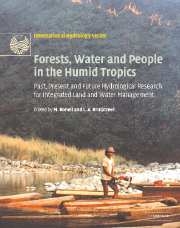 Forests, Water and People in the Humid Tropics
Forests, Water and People in the Humid Tropics from Part V - Critical appraisals of best management practices
Published online by Cambridge University Press: 12 January 2010
INTRODUCTION
Rainfed farming continues to expand in the humid tropics as the population grows, and natural forests are being replaced by agriculture on increasingly steep hillsides. This process may be abrupt but more often occurs through a series of gradual changes in land use: from forest modification, to shifting agriculture, through settlement mosaics and on to eventual complete forest replacement (Sayer et al., 2000). Often, the gradients in question are above theoretical legal limits for cultivation (Moldenhauer and Hudson, 1988) (Figure 38.1). The challenge is to identify and offer practical solutions for soil and water conservation in these areas that are both technically appropriate and socially acceptable. It is increasingly realised that measures must address water, fertility and production aspects simultaneously, as well as the prevention of surface erosion. These systems should be sound in technical terms so that they control damage to the soil and to the hydrological integrity of the hillsides. They should also sustain plant production. Social acceptability is the acid test of adoption: if ‘solutions’ are not attractive to land users they will not be sustained and they will not spread.
Since world-wide concern with soil erosion (‘the problem’) and soil conservation (‘the solution’) spread in the 1930s and 1940s, catalysed by the great dust bowl phenomenon in the United States (Anderson, 1984), there have been significant shifts in conceptual thinking. In summary, it has been recognised that top-down schemes based on engineering techniques have largely failed to deliver.
To save this book to your Kindle, first ensure [email protected] is added to your Approved Personal Document E-mail List under your Personal Document Settings on the Manage Your Content and Devices page of your Amazon account. Then enter the ‘name’ part of your Kindle email address below. Find out more about saving to your Kindle.
Note you can select to save to either the @free.kindle.com or @kindle.com variations. ‘@free.kindle.com’ emails are free but can only be saved to your device when it is connected to wi-fi. ‘@kindle.com’ emails can be delivered even when you are not connected to wi-fi, but note that service fees apply.
Find out more about the Kindle Personal Document Service.
To save content items to your account, please confirm that you agree to abide by our usage policies. If this is the first time you use this feature, you will be asked to authorise Cambridge Core to connect with your account. Find out more about saving content to Dropbox.
To save content items to your account, please confirm that you agree to abide by our usage policies. If this is the first time you use this feature, you will be asked to authorise Cambridge Core to connect with your account. Find out more about saving content to Google Drive.